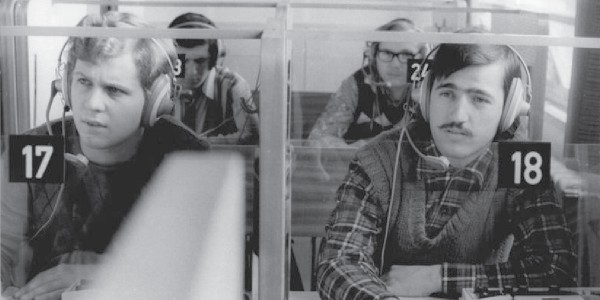Can You Learn A Language With The Army Method?
My grandmother learned French at school in Australia in the late 1950s. For years she studied it dutifully, and the one phrase that she recalls vividly to this day is: La plume de ma tante est dans le jardin avec le lion. For those who never had the pleasure or pain of learning French, it translates to “My aunt’s pen is in the garden with the lion.” Difficult to slip into casual conversation, to say the least.
She was not alone in learning this phrase – la plume de ma tante was a byword in ridiculous second language education, to the extent that in 1958 LIFE Magazine called it “the most idiotically useless phrase in a beginner’s French textbook.”
My grandmother, wonderful woman that she is, is not renowned for her memory. She has been known to spend time searching for her glasses only to discover them in the fridge. Furthermore, she is now in her 80s. So why does she remember this phrase so clearly?
Language learning (or language acquisition as we are now supposed to call it) was a very different kettle of fish in the decades after World War II. It was a world of chalk and blackboards and grammar drills, and it was dominated for many years by a method appositely called the “Army method” — more officially termed the Audio-Lingual Method, or ALM.
ALM was heavily influenced by Harvard psychologist B.F. Skinner’s behaviorist theory that humans could be trained with a system of reinforcement. When a child says “up” and she is picked up, they will remember the experience and her understanding of the word will be deeper, so they will be more likely to use it correctly in the future.
What did this mean in practice? Drills, drills, and more drills. A typical lesson would often start with a sample dialogue that had to be memorized and recited. This would be followed by drills designed to reinforce the new structure, either with direct repetition, substitution or restatement. Let’s look at a simple example.
Teacher: I bought a sandwich.
Students: I bought sandwiches.
Or, a more complex example.
Teacher: My pen is on the table.
Students: My pen is on the table.
Teacher: …under the chair.
Students: My pen is under the chair.
Teacher: …in my pencilcase.
Students: My pen is in my pencilcase.
If this sounds a bit like the call-and-reply of a drill sergeant barking at a platoon of soldiers, it’s because that’s exactly what it was. World War II was a key factor in ALM’s rise to prominence. The army needed huge numbers of servicemen as interpreters, code-room assistants and translators. Charles Fries, a structural linguist and director of the first English Language Institute, had developed a method that used intensive drilling of basic sentence patterns. “It is these basic patterns that constitute the learner’s task. They require drill, drill and more drill, and only enough vocabulary to make such drills possible,” he said. Many soldiers were trained intensively in a short space of time, with a high success rate.
After the war, stung into action by fear of being left out of international scientific advances – particularly when the Russians launched a space satellite — the U.S. government decided its citizens had to learn more languages, and threw money at the problem with the National Defense Education Act. Language teaching specialists drew on Fries’ structural linguistics and combined it with the principles of behavioral psychology, and voilà! The Audio-Lingual Method was born.
Although the method is absolutely grammar-focussed, it never explains or contextualizes the grammar. There is no “cognitive” aspect, where the teacher explains complex topics (something the Babbel Method uses). In ALM, only the target language is spoken by the teacher, and students are expected to learn the patterns through mechanical repetition.
 Photo: Bundesarchiv, Bild 183-P0422-0004 / CC-BY-SA
Photo: Bundesarchiv, Bild 183-P0422-0004 / CC-BY-SA
Language labs were a big part of the methodology. Students would sit in cubicles, listening and repeating, often recording their voices and listening to the playback.
For anyone born after 1980, this kind of approach to language learning may sound like a bygone era. Indeed, the first time ALM was attacked was in 1959, when linguist Noam Chomsky called Skinner’s behaviorist theory “a serious delusion.” Behaviorism fell out of favor, new cognitive and communicative methods of language learning were adopted, and ALM was considered mostly discredited by the 1970s.
So what’s Eddie Izzard going on about?
In fact, reports of the death of the Army method have been greatly exaggerated. It may not form the core of what is taught in classrooms these days, but its principles and tenets are still with us.
The idea that students are taught only in the target language rather than their mother tongue never left us. Immersive and communicative methods do this too. English as a Second Language teaching is based on this principle, not only from a pedagogical perspective but out of sheer practicality. The language lab may look a little different with computers instead of tape decks or cassettes, but it’s still there.
Walk into any foreign language classroom and there’s a good chance that there will be a drill at some point in the lesson. The style and purpose of the drill may differ — they’re often used to work on pronunciation rather than grammar — but this is a direct legacy of the Army Method.
So next time a strange phrase pops into your head that got stuck there during a French or German lesson many years ago, don’t be alarmed. It’s just one of the colorful side effects of learning a new language. At least you don’t have to worry about your grandmother getting eaten by a lion while trying to retrieve her aunt’s pen.
Does this sound familiar? Have you ever learned with the ‘Army method’? Leave us a comment!
RECOMMENDED NEWS

What We Learned Responding To The War In Ukraine
Russia launched a war of aggression against Ukraine on February 24, 2022. In the months since, over ...

Vacation Cheat Sheet: 31 Russian Phrases You Need To Know
It can sometimes feel like the only way to learn a language is to tackle the entire thing. Languages...

5 Embarrassing Mistakes English Speakers Make In French — And How to Avoid Them
Mistakes are an unavoidable but essential part of the language learning process. Sometimes they’re f...

A Helpful Guide To Solo Travel For Female/LGBTQ+ Travelers
In the past, solo travel wasn’t a hugely popular pastime. Moreover, it wasn’t considered to be widel...

The Korean Language: A Window Into Korean Culture And Identity
The Korean language, known as 한국어 (Hangugeo) in South Korea or 조선말 (Chosŏnmal) in North Korea is muc...

Unlocking Potential: How Early Childhood Education Shapes a Child’s Future
The Importance of Early Childhood Education As a parent, I have always believed that education is t...
Comments on "Can You Learn A Language With The Army Method?" :